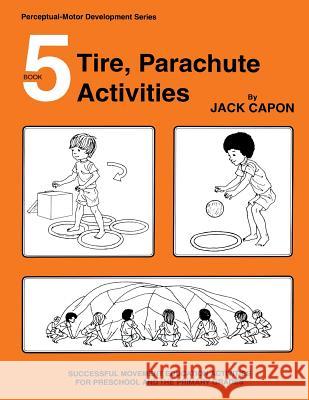Tire, Parachute Activities » książka
Tire, Parachute Activities
ISBN-13: 9781489546227 / Angielski / Miękka / 2013 / 48 str.
This book is divided into 2 Parts: Part 1--Tire Activities; and Part 2--Parachute Activities. The book consists of 36 pages and all the activities are sequenced according to difficulty. PART 1 introduces the student to Tire Activities that consists of bicycle tires which are among the most versatile, inexpensive, indestructible and easily obtained teacher tools available for use in the physical education program. They are safe, easy to handle and their shape makes them convenient for storage. Bicycle tires, being lightweight, are more practical than automobile tires thereby allowing for a greater variety of uses. The tires can be painted in a variety of colors and when used with colored bean bags, children can toss the red bean bag into a red tire, blue bean bag into a blue tire, etc. Matching objects that are the same color develops visual perception in your children and reinforces the same skills that are used in a reading readiness program. By using color labels, children can match the word to the appropriate colored tire, thereby helping to build and strengthen the bridge between cognition and language. (Note that, of course, if necessary, due to your particular circumstances, plastic hoops could be substituted for the rubber bicycle tires. However, within this series of 5 books, plastic hoops are already used in their own activities in Book 2. Varying the use of different equipment items keeps the children interested and engaged. Using new equipment items will keep the children from getting bored with the same old items and signal brand new motor development activities and more fun ) PART 2 introduces the student to Parachute Activities that utilize the parachute which represents an exciting catalyst for movement in the physical education program. Movement means life. It means freedom, pleasure, communication and sensuous enjoyment. Inflating the canopy requires teamwork and cooperation. A child learns first hand the meaning of total involvement and so moving through space he gains an understanding of his physical relationship to the real world. The games and exercises develop and strengthen arm and shoulder muscle development and at the same time strengthens wrist and finger muscles. There are wide variations in interests and abilities within a given group, however, all students, regardless of skill and strength, can participate successfully and non-competively in parachute activities. A child must be aware of himself. With this knowledge he is better able to know where he is in space and how he can control his movements. This self-discovery is unique to each child as he explores the infinite number of alternatives in working out a challenge. And as he discovers himself, he will become more accepting of classroom challenges. These parachute activities assist him in improving his sense of rhythm, his basic motor skills and his self-confidence; qualities which have a direct relationship to his physical maturity and his academic performance. The teacher might also want to give the class a brief historical background about the parachute. This could prove stimulating to the children and perhaps would encourage the students to pursue the subject further. The parachute lends itself to both indoor and outdoor use. Space permitting, it is a marvelous activity for rainy days. Each child achieves immediate success and gratification. The removal of competition and the risk of failure, creates a positive attitude toward learning both in and out of the classroom.
Zawartość książki może nie spełniać oczekiwań – reklamacje nie obejmują treści, która mogła nie być redakcyjnie ani merytorycznie opracowana.











